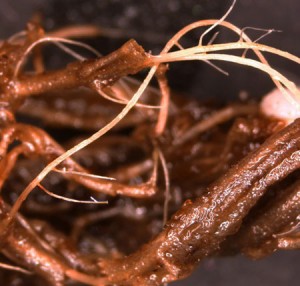If you’ve been warmer than you’d like of late, so have your mums. Pythium root rot likes it hot — and it likes mums, especially when their roots are stressed. Though this killer disease is widespread, it keeps a low profile when conditions don’t suit it — kicking into high gear when they do.

Say it’s hot … PLUS raining buckets … PLUS water is pooling on your growing pads … EQUALS … well, you do the math.
A whole slew of plant diseases share the “Pythium” family name, but what we’re looking at here is Pythium aphanidermatum. This water-mold fungus hides out on dirty flats and trowels or in potting media, or sneaks in on cuttings. Pythium root rot is hard to control once it’s gotten a hold, so prevention is the name of the game.
A too-hot, too-dry, too-wet routine stresses those roots; so does poor nutrition. Basic cultural controls like good sanitation and transplanting during cool morning or evening hours can help. And vigorous, well-nourished (but not over-fertilized) transplants are often more tolerant of rot.
If you’re struggling with recurrent pythium root rot, start with your classic cultural controls. But also consider a preventive drench or biological control agent, applied as early in the cropping cycle as possible. Remember to rotate drench materials — some populations of pythium are now resistant to certain commonly used fungicides.